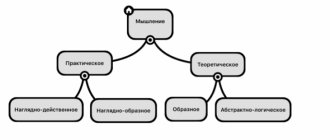What is thinking
Thinking is a cognitive process that allows a person to perceive, realize reality and express this in his own activities. It endows surrounding objects with properties and relationships with each other. Thanks to mental activity, each person’s picture of the world is formed.
There are the following main signs of thinking:
- Mediation – cognitive activity is based on data from the senses and does not interact directly with reality;
- Generalization is the ability to find common properties in objects of the same type.
These characteristics are inherent in every person. In mental illness, a disorder in the basic features of thought processes may occur - for example, the search for similarities in dissimilar objects.
Right-brain and left-brain thinking
Each hemisphere is characterized by the predominance of certain processes. Based on this feature, the main types of thinking were identified:
- Left hemisphere - the process is dominated by analytical and synthetic processes, logical constructions;
- Right-hemisphere - relies on images and intuition;
- Mixed is the alternate work of each hemisphere;
- Integrated – simultaneous work of both hemispheres.
It is wrong to say that one type of mental activity is preferable to another. Each of them is capable of coming to both correct and incorrect conclusions. Left-hemisphere thinking gives leadership qualities, right-hemisphere thinking gives a strong emotional response. Mixed, thanks to its ability to “switch,” can use the strengths of both hemispheres. But this process does not always happen on time. The same goes for the integrated type.
Characteristics of the main types of thinking
There are two main types of thinking:
- theoretical;
- practical.
The first allows you to think about distant objects and situations that are not in the field of view, the second requires the direct participation of the senses: vision, touch, smell and hearing.
The type of theoretical thinking of a person can be divided into:
- conceptual – it is based on already existing information in the form of established concepts, on the basis of which new conclusions are drawn;
- figurative – when, in the process of the birth of a thought, consciousness uses images, recreating them from memory;
- abstract-logical - does not use images and forms; it is used when one cannot rely on a visual form.
Practical thinking is divided into:
- Visual and effective - carried out in the process of working with objects. A striking example of such thinking can be the process of assembling a puzzle by a child. During the game, tactile contact, thinking, and the birth of a conclusion occur.
Child and puzzle
- Visual-figurative – possible when using images as an addition to a visual picture. An example of such thinking could be design work, in which a person sees the existing interior and, using images, reflects on the topic of rearranging, repairing or new furniture.
Also, thinking can be analytical and intuitive, depending on the degree of deployment in time. Analytical thinking involves logic and experience and takes time. Intuitive is based on sensations and has a high flow rate.
According to the degree of novelty, they are distinguished:
- reproductive – generating conclusions based on existing skills, most often by analogy with some example;
- productive - creating a solution based on your own ingenuity.
Productive thinking
Classification
In psychology, types of thinking are distinguished depending on the way a person comes to conclusions:
- Visual-effective - cognitive activity based on the perception of specific objects and manipulations with them;
- Visual-figurative – relies on images and judgments, allows the use of specific images to illustrate conclusions;
- Verbal-logical – based on logical constructions and inferences. Able to reason about abstract concepts;
- Subject-effective – close to visual-effective. Used to solve applied problems;
- Empirical - using lived experience to make inferences.
Each person has all types to one degree or another. The verbal-logical or abstract type develops later than the others. Characteristic only for humans. Other types appear to varying degrees in some animals. In essence, abstract thinking allows a person to use a wide conceptual apparatus and transfer knowledge through indirect sources - a book, an educational film, etc.
What types of thinking exist in children?
Children begin to use the visual-effective type of thinking first. They see an object, they need to find out what it is. So they need to touch everything.
Then visual-figurative thinking is developed. In order to think, images must be “prepared” in the head. This is why young children (up to 7 years old) need to leaf through picture books, study what is happening on the street, or watch cartoons.
And verbal-logical thinking appears already in teenagers.
Visually effective type
This is the earliest form of mental activity that develops in humans. It is typical for children under 3 years of age. Mental operations are based on manipulations with really existing tangible objects. Each problem is solved immediately at the practical stage, during manipulations with objects. Thinking disorders of this type are rare. Mainly with severe mental retardation. They lead to the fact that the process of development of brain activity as a whole slows down or stops.
How and when does developmental disorder develop?
This is the first stage in the development of mental activity. The time frame for its development to begin varies. Some experts indicate that a child is capable of simple mental operations from birth. Others say that the development of mental processes is closely related to the ability to move and appears simultaneously with a decrease in muscle hypertonicity. Estimated time frame: 6 months – 1 year.
Vivid and uncontrolled manifestations of visual-effective thinking in children over 3 years of age, adolescents and adults indicate serious mental disorders - mental retardation, regression in psychosis. The patient exhibits a pronounced desire to grab, break and hide surrounding objects.
Manual or visual-effective thinking of children and ways of its development
This type of solving life problems got its name due to the fact that the child constantly performs some kind of manipulation with surrounding objects. The most striking manifestations are the baby grabbing toys, knocking them, testing them, licking them, trying to take them apart and put them back together.
It makes no sense to wean a child from these manipulations; a much more important task for parents is to provide the child with toys that he can disassemble and assemble without damaging them. An excellent option is sorters. This educational toy has many functions and modifications. The principle of operation is usually similar - assemble, disassemble, correlate colors, edges, shapes. This is both a puzzle and a construction set in one toy. Check out the selection of smart toys in different prices and variations.
Visually effective type of thinking in adults
In adults, such mental operations are involved in cases where the result of actions cannot be predicted on the basis of existing inferences. A striking example is mastering an unfamiliar technique. Arrangement of furniture in the room or objects on the table, selection of necessary materials according to shape, texture, subjective sensations.
What are the features of development, when it is formed and clearly manifested?
In preschool children
In young children who have not yet reached 4 years of age, acquaintance with the world occurs through interaction with objects and touch, so the peculiarity of these preschoolers is that in the first place they still have effective thinking (more about the features of visual-effective thinking in children we told here).
From 4-5 years old, children can already imagine various situations in their heads and can find an object based on its verbal description. A child of this age is characterized by a more extensive picture of the world.
For primary and secondary schoolchildren
The new environment changes the child’s way of life, his social roles in the team and family. In an educational institution, tasks become more complicated, and the student’s mental activity ceases to rely only on the practical component. In order to solve problems, you need to learn to reason and analyze, and these are new mental operations. And this is where imaginative thinking begins to work (for why you need to improve imaginative thinking in adults and children and what methods and techniques for its development are available, read here).
The main difficulty in the correct mental development of children of primary preschool age is that they quickly lose interest and, as a consequence, the essence of the process. By middle school age, a child can already plan. Correctly formed visual-figurative interaction at this point contributes to better learning of new subjects at school.
In the lives of teenagers
Attention. During adolescence, there is a big leap in mental activity. The evolution of figurative cognition occurs in conjunction with speech changes.
Visual-figurative thinking at this stage is associated with the following manifestations: the teenager strives for correct definitions and logical justifications, sentences with a complex structure appear more often in speech, and it becomes more expressive.
A good level of all types of thinking allows one to begin a consistent study of the fundamentals of science in adolescence. New school subjects require generalization of experience, handling complex concepts, the ability to think independently, compare and reason, and the development of these skills is formed on the basis of visual-figurative thinking and is closely related to it.
What does it mean in adults?
In adults, visual-figurative thinking interacts with practical thinking, this allows you to act according to the situation. Throughout human history, imaginative thinking has allowed people to improve their manual skills. A high level of such thinking in adulthood improves creative abilities, increases the degree of creativity and the generation of new ideas. It also improves different areas of memory, inner sense and allows you to feel free in unfamiliar situations.
What professions require it?
Creative professions require the use of imaginative thinking and creativity, which comes from it and will work in tandem with a person’s analytical abilities. Imagery contributes to the development of a sharp mind and the desire to expand one's horizons. The ability to find non-standard approaches to various situations will help you get out of them easier and faster. And the ability to visualize desires and dreams will make their fulfillment more achievable.
Visual-figurative type
This form of thinking manifests itself in the fact that the child is able to imagine the final result of his actions. With the visually effective method, the baby has no idea about the result of his actions, but remembers the relationships as a result of repetition. With visual-figurative learning, the preschooler guesses what the result will be.
How and when it develops, what developmental disorders exist
Visual-figurative thinking is formed on the basis of visual-effective thinking. Formation begins at the age of about 3 years. This is the main type of mental activity of preschoolers. Reaches a peak at 5-6 years.
Signs that the baby has the beginnings of imaginative thinking:
- he is able to recognize objects without touching them,
- is able to select several similar objects,
- break simple tasks into several interconnected components.
Tools for developing an imaginative way of thinking - prefabricated toys (pyramids, cubes, puzzles -), then - observing nature, retelling what you heard, drawing from memory. The criterion that imaginative thinking is actively developing is that the baby can describe his actions before starting them.
Visual-figurative thinking disorders in childhood are a lack of skills characteristic of this stage, loss of interest in complex toys. In adults, such disorders look like this:
- Aimless manipulation of objects. Example – a patient may strike a lighter for a long time and aimlessly;
- Ridiculous actions with objects that create the feeling of a child's game;
- Imitative actions;
- Mimo actions - similar to correct ones, but deliberately ineffective (lighting a match with the other end);
- Destructive actions - aggressive or auto-aggressive.
This behavior is typical for patients with psychosis, catatonic disorders, and schizophrenia.
How do images help in mental activity?
An image is a holistic idea of the result of one’s activities. It becomes the basis for the formation of more complex abstract thinking and supports the ability to perceive holistically. In adults, the main function of images is setting goals for their actions, emotional involvement in activities, and the formation of a creative approach.
Important
Imaginative thinking can only work with those phenomena that it has already encountered, so observation is extremely important at this stage of development. Emotions are always included in the perception of an image - this is important for both children and adults engaged in creative work. At the same time, this type of brain work is not characterized by special attention to detail - it notices the important and essential qualities of an object, while the rest can be distorted or discarded.
Development of imaginative thinking
Visual-figurative thinking is a set of methods and processes for imaginative problem solving, involving a visual representation of a situation and operating with images of its constituent objects, without performing real practical actions with them. Such thinking allows us to most fully recreate the variety of different actual characteristics of an object. An important feature of this type of thinking is the establishment of unusual combinations of objects and their properties. In this capacity, visual-figurative thinking is indistinguishable from imagination.
Visual-figurative thinking and imagination are different processes. The visual-figurative deals with a real object, process. Imagination is the reconstruction of the desired image from figurative memory.
How are you doing with your imaginative thinking? Look at the palm of your left hand. Study it carefully. Pay attention to lines, cracks and moles, and patterns on the skin. Admire how the play of light and shadow creates subtle changes in color. After about a minute, when you have a clear idea of what your palm looks like, close your eyes and try to reproduce its appearance in your mind, create a clear mental image of your palm.
After a while, open your eyes, look at your palm and compare it with the picture you painted in your imagination. Notice what was present and what was missing in the image you created.
Then close your eyes and imagine your palm again. Imagine what it would look like if you looked at it with your eyes open. After another half a minute, open your eyes and look at your palm. Repeat the entire cycle at least six times. Each time, try to add even more clarity to the image you created.
If the image is not as clear as you would like, do not force it to become clearer by force of will; rather, try to go through the signs without stress, visualizing sequentially the shape, texture, size, color.
To increase the brightness of the mental “image”, you need to turn off verbal (verbal) thinking, just look, but not describe it in words.
You can use your imagination to relieve stress, gain emotional balance, gain a positive attitude, and successfully interact with your business and personal environment - feeling it better and finding mutual understanding. Below we offer you several exercises for developing imaginative thinking.
1. Mental image of a holiday dinner
Take a minute or two to mentally picture the last holiday dinner you attended: imagine the people you were with, the surroundings, the table decorations, the taste of the food, the words and sounds that came to you. So, before you continue reading, take a break for a while and try to create an image, being careful not to lose sight of the details. Get started now.
Then answer the following questions:
- Is the image you created clear or blurry?
- Tell me, did the picture turn out dimmer than the real scene or not?
- Are the details of the particular scene you've chosen clearly visible all together, or do some stand out more than others?
- Is the picture that appears in your imagination colored or just grayish?
- If the painting is in color, are the color tones accurate?
- Can you create a cohesive visual image of the entire room?
- Can you retain a stable image of your plate in your mind? If this is real, tell me, does it become clearer as time passes?
- Can you mentally see your plate, your hands holding a knife and fork, the face of the person sitting opposite you - all at the same time?
- Can you describe how people were dressed?
2. Real object
Imagine each of the following objects:
- person's face;
- childhood friend;
- running dog;
- your bedroom;
- sunset;
- flying eagle;
- babbling brook;
- drop of dew;
- Spindrift clouds;
- computer keyboard;
- oak grove;
- snowy peak;
- toothbrush;
- your favorite pair of shoes.
If the images that arise are not as vivid as you would like, do not try to forcefully improve them.
Instead, focus on the very idea of gazing at the image. Remember: everything you are trying to imagine has a shape, quality, color and size. Focus on the form first and then dive into the details. Give the image time to become stable and sharp. 3. Not a very real object
What is the difference between images of objects that you have seen and images of objects that you have never seen? Paint the following pictures in your mind:
- unicorn;
- chocolate river;
- six-armed god;
- talking giraffe;
- thirty-legged ant;
- choir of angels;
- four-dimensional sphere;
- hobbit;
- five leaf clover.
4. Squares of lateral vision
Keeping your gaze motionless, try to look at the periphery of your field of vision. Use your peripheral vision to see as much as possible. Then close your eyes and try to recreate the image of what you saw. Mentally divide the space you are observing into four parts. Select a square and analyze every detail in that square, then mentally recreate it. Repeat this with each square.
5. Five mental pictures
- Imagine five blue objects (blueberries, sky, book cover...).
- Do the same with other colors: red, yellow, green, purple...
- Visualize clearly five objects starting with the letter “A” (artichoke, amphora...).
- Do the same with each letter of the alphabet.
- Imagine five objects smaller than your little finger (pen cap, pea, nerve cell...).
- Imagine five objects larger than a bus (whale, train...).
- Imagine five objects located underground (roots, earthworms...).
- Imagine five things that bring you joy (skiing, swimming in the sea, ice cream, a walk in the forest...).
6. Visual trace
If, after looking at a certain object, you close your eyes, then its image will automatically remain in your memory for some time. Try to connect your visual memory with your mental image. For example, look at a pen, close your eyes and admire the picture stored in your memory. When the image fades, open your eyes, look at the pen, close your eyes again and look at the image in your memory again. Repeat this several times at your own pace until you have a clear picture, at least for a second. After this, try to consciously reproduce the mental image of the pen.
7. Peripheral mental vision
Mentally imagine a pen located directly in front of you. Then also mentally begin to slowly move it in space - so that it is first to your left, then behind you, then to your right and, finally, in front of you again. As you move the pen, imagine that you are using your peripheral vision to follow it.
8. Mental portraits
Think about all the people you talked to today. What did they look like? What color are their hair and eyes? What height and age are they? What were they wearing? Can you imagine their manners and habits? Draw portraits of people you saw yesterday; last weekend; during the last vacation; on my last birthday.
9. Geometric bodies
Most mathematical operations are performed on imaginary objects. Imagine each of the following three-dimensional solids:
- sphere;
- cube;
- prism;
- tetrahedron;
- pyramid;
- dodecahedron;
- octahedron;
- icosahedron
Don’t try to create an image right away: first, study in detail the spatial relationship of the flat edges.
Mentally manipulate bodies, examining them from all sides, including from the inside. Try to get a feeling of the volume of your body. 10. Feelings and nothing but feelings
Imagine a positive emotion. Imagine the feeling of amazement without having any specific object or memory in mind. Try to imagine a desire without wanting anything in particular. How vividly can you mentally reproduce the following experiences: hope, joy, pleasure, love, anger, apathy?
11. Setting up your TV
Pick a specific object, such as a blueberry cheesecake, and try to create a clear image of it in your mind. Imagine being able to adjust the internal picture quality, just like you can press buttons to adjust your TV.
First, form a stable image of a cheesecake and increase the sharpness. Can you spot the crumbs? Can you see the shade of the berries? Can you tell the color of the dough? Then turn the sharpness control until the image is blurry and unclear. Then turn the knob in the opposite direction again until the image is as clear as possible. How many details can you see in the cheesecake crumbs? Is the emerging image three-dimensional? Next, turn the sharpness control in the opposite direction again and make the image blurry again. Alternately form a clear and sometimes vague picture until this shift becomes technically feasible for you. Try to adjust other switches in the same way.
12. Images of ideas
Imagine the idea of Beauty. Tell me, do you see a certain image of something very beautiful or are you able to create an abstract image of Beauty without imagining anything concrete or private? Do you connect sounds, smells, taste sensations with your idea of Beauty? How big or small is this idea? Here are a few more abstract concepts that you are asked to create an image of: betrayal, order, energy, peace, harmony, communication, reality, illusion.
Upcoming free webinars
- 23.09.2021
Tax audits 2021-2022: trends you need to know about - 24.09.2021
Tax against business: subsidiary liability - 28.09.2021
Distinction between movable and immovable property in disputes with the Federal Tax Service
Abstract boolean type
Abstract thinking operates not only with images, but also with abstract concepts. A person who has developed this type of mental activity is able to systematize information and purposefully search for it, and plan his activities. It is considered the highest degree of development of brain activity, characteristic only of humans.
How and when it develops, possible developmental disorders
The formation of abstract thinking begins at 5-7 years of age. Late preschool and early school period. The full ability to operate with abstract concepts is formed in adolescents and remains throughout life.
Signs that a preschooler has begun to develop logical thinking:
- meaningful use of abstract concepts in speech,
- the emergence of the skill of detailed planning of one’s activities,
- understanding cause-and-effect relationships in the actions of others.
All these operations occur without direct contact with objects.
Impaired brain activity manifests itself in the inability to generalize, highlight the main thing, and understand the figurative meaning of words and expressions. To identify such disorders, tests are used in which you need to interpret a proverb or saying and identify fundamental similarities between different objects.
Peculiarities
This type of thinking uses complex logical operations. In adolescents and adults it is the main one. Thanks to it, a person is able to plan, set goals and evaluate their feasibility, evaluate his own actions and the actions of others, draw conclusions and learn from his own and others’ experiences. Characterized by deep attention to detail, understanding of context, low emotional involvement.
Give examples of types of thinking
In psychology, there are mainly three types of thinking: visual-effective (concrete-visual), figurative and abstract-logical (theoretical). The first two types are combined under the name of practical thinking. Visual-effective thinking is the simplest known type of thinking, characteristic of many animals and probably dominant among primitive people. It can be noticed in young children, starting from the sixth to eighth month of life. An example of this type of thinking is reaching distant objects by overcoming physical obstacles on the way to them. If a child wants to take an object that is attractive to him, which lies far away and which cannot be reached with his hand, then he can use a stick for this. If the attractive object is located high up, the child can use a chair to get it. All these are examples of visually effective thinking. It represents genetically the earliest type of human thinking and, at the same time, its simplest type.
Visual-figurative thinking is called thinking in which problems are solved by a person not by manipulating real, material objects, but by internal, psychological actions and transformations of the images of these objects. Instead of practically solving the problem of conveniently arranging furniture in a room, moving heavy objects from place to place and observing what happens as a result, a person can mentally rearrange these objects and, having obtained a situation as a result of a figurative transformation, evaluate the result. This will be an example of solving a problem in a visual-figurative way or an example of turning to visual-figurative thinking. This type of thinking appears in children aged 3-4 years.
Abstract-logical thinking operates with concepts, judgments, symbolic and other abstract categories. The meaning of concepts is especially clear in the example of the thinking of deaf and dumb people. It has now been experimentally established that deaf-mute people from birth usually do not rise to the level of conceptual thinking. They are limited to reflecting primarily visually these signs, i.e. use the means of visual and effective thinking. Only under the condition of mastering speech, i.e. from the time when concepts arise and the deaf-mute have the opportunity to operate with them, their thinking becomes conceptual—abstract-logical. Abstract logical thinking is the most profound and effective, but presupposes the presence of sufficient knowledge and skills. Abstract logical thinking is characteristic of an adult.
17. Explain the concept of temperament and indicate the areas of its manifestation.
Temperament should be understood as individually unique properties of the psyche that determine the dynamics of a person’s mental activity, which are equally manifested in a variety of activities, regardless of its content, goals, motives, remain constant in adulthood and, in their mutual connection, characterize the type of temperament. Specific manifestations of the type of temperament are diverse. They are not only noticeable in the external manner of behavior, but seem to permeate all aspects of the psyche, significantly manifesting themselves in cognitive activity, the sphere of feelings, motivations and actions of a person, as well as in the nature of mental work, features of speech, etc.
SANGUINE. A person with increased reactivity, but at the same time his activity and reactivity are balanced. He responds vividly, excitedly to everything that attracts his attention, has lively facial expressions and expressive movements. For an insignificant reason he laughs, but an insignificant fact can make him angry. From his face it is easy to guess his mood, attitude towards an object or person. He has a high sensitivity threshold, so he does not notice very weak sounds and light stimuli.
Possessing increased activity and being very energetic and efficient, he actively takes on new work and can work for a long time without getting tired. He is able to concentrate quickly, is disciplined, and, if desired, can restrain the manifestation of his feelings and involuntary reactions. He is characterized by quick movements, flexibility of mind, and resourcefulness. fast pace of speech, quick integration into new work. High plasticity is manifested in the variability of feelings, moods, interests and aspirations.
A sanguine person easily gets along with new people and quickly gets used to new requirements and surroundings. Without effort, he not only switches from one job to another, but also relearns, mastering new skills. As a rule, he responds more to external impressions than to subjective images and ideas about the past and future, an extrovert.
For a sanguine person, feelings arise easily and are easily replaced. The ease with which a sanguine person forms and remakes new temporary connections, the greater mobility of the stereotype, is also reflected in the mental mobility of sanguine people, and reveals a certain tendency to instability.
CHOLERICK. Like a sanguine person, he is characterized by low sensitivity, high reactivity and activity. But in a choleric person, reactivity clearly prevails over activity, so he is unbridled, unrestrained, impatient, and quick-tempered. It is less plastic and more inert. Than sanguine. Hence - greater stability of aspirations and interests, greater perseverance, difficulties in switching attention are possible, he is more of an extrovert.
PHLEGMATIC has high activity, significantly prevailing over low reactivity, low sensitivity and emotionality. It is difficult to make him laugh and sadden - when people laugh loudly around him, he can remain calm. In big troubles he remains calm.
Usually he has poor facial expressions, his movements are inexpressive and slow, just like his speech. He is unresourceful, has difficulty switching attention and adapting to a new environment, and slowly rebuilds skills and habits. At the same time, he is energetic and efficient. Characterized by patience, endurance, self-control. As a rule, it is difficult for him to get along with new people, he responds poorly to external impressions, he is an introvert, the disadvantage of a phlegmatic person is his inertia and inactivity. Inertia also affects the rigidity of its stereotypes and the difficulty of restructuring it. However, this quality, inertia, also has a positive meaning, contributing to the solidity and constancy of the personality.
MELANCHOLIC. A person with high sensitivity and low reactivity. Increased sensitivity with great inertia leads to the fact that an insignificant reason can cause him to cry, he is overly touchy, painfully sensitive. His facial expressions and movements are inexpressive, his voice is quiet, his movements are poor. Usually he is unsure of himself, timid, the slightest difficulty makes him give up. A melancholic person is not energetic, unstable, gets tired easily and is not very productive. It is characterized by easily distracted and unstable attention and a slow pace of all mental processes. Most melancholic people are introverts. The melancholic person is shy, indecisive, timid. However, in a calm, familiar environment, a melancholic person can successfully cope with life’s tasks. It can be considered already firmly established that a person’s type of temperament is innate, but what specific properties of his innate organization it depends on has not yet been fully clarified.
The way a person implements his actions depends on temperament, but their content does not depend on it. Temperament is manifested in the peculiarities of the course of mental processes. Influencing the speed of recollection and strength of memorization, fluency of mental operations, stability and switchability of attention.
Specific subject type
A selection of construction kits that perfectly develop subject-specific thinking
Like visual-effective thinking, the concrete-object type is associated with direct interaction with objects, but is its more developed type. A person with concrete-subject thinking, unlike a small child, has a goal and imagines the result of his actions. This type of mental activity accompanies applied operations, most often in the technical field. It allows you to “adjust” certain devices to a specific situation.
How and when does developmental disorder develop?
Practical thinking begins to develop around 4-7 years, the start time is quite flexible. What is needed is a developed visual-figurative method and the presence of at least the rudiments of the abstract-logical. This type of mental activity is formed on the basis of constant work with hands, requiring a creative approach. He is well developed by construction sets and other complex toys - a good selection.
Developmental disorders manifest themselves in the form of an inability to follow instructions, difficulty in moving from theory to practice.
Practical thinking
The purpose of this type of thinking process is to prepare a specific physical transformation of reality: for example, creating a plan, project, diagram. In other words, it is aimed at solving specific practical problems. Usually practical thinking is limited by time constraints.
Visually effective thinking manifests itself in practical activity, during which we transform real objects. With this prevailing type of thinking, a person directly perceives an object or, in the process of some action with it, changes and transforms the situation. Who uses visual-effective thinking most often? These are, as we have already said, children under three years of age and adults engaged in the creation of any material product (for example, in production).
Visual-figurative thinking is different in that the thought process in this case occurs directly in the process of perceiving the surrounding world, and only this way. With this type of thinking, a person imagines the situation and the changes that he wants to achieve in the final result. Visual-figurative thinking is characterized by the use of unusual, incredible combinations of objects and their properties. With this type of thinking process, a person uses images presented in his operational and short-term memory (and does not retrieve them from long-term memory with subsequent transformation, as happens when using theoretical figurative thinking).
Who uses visual-figurative thinking most often? First of all, these are children: preschoolers and primary schoolchildren, and among adults - those who are engaged in practical activities, if they observe the subject of their activity without touching it. When renovating an apartment and imagining the final result, based on the selected wallpaper options, the color of the ceiling and floor, we also use this type of thinking.
Forms (criteria) of thinking
Thinking operates with several basic categories, which are characteristic mainly of the abstract-logical type.
- A concept is the simplest act of mental activity. It reflects the very fact of understanding objects or phenomena. The external manifestation of the concept is the ability to name an object using its main features (black cat, cold rain, bad mood, etc.).
- Judgment is the ability to establish relationships between concepts and combine them into groups. External expression is the ability to describe one concept using others in a sentence. Examples of judgments: a cat and a dog are animals; rain is precipitation in the form of water.
- Inference - allows you to derive new judgments from existing ones that are interconnected. An example of a conclusion: rain is precipitation in the form of water, in winter the water freezes, which means rain is possible only in summer. Inferences can be true or false. An example of an incorrect inference is that a cat is an animal, the cat meows, which means all animals meow.
A separate type of inference is a hypothesis. It is based partly or entirely on assumptions and requires verification and evidence. In everyday life, a person makes several hundred inferences a day. For example, from the readings of the thermometer outside the window, he makes a conclusion about what clothes to wear.
How to develop visual-figurative thinking?
In this case, various games and exercises will come to the rescue.
The most effective way to develop visual-figurative thinking is activity that allows you to translate your plans into reality. For kids, this is, first of all, any types of construction and all kinds of didactic games aimed at developing thinking and imagination. Let us consider in more detail the techniques that promote the development of imaginative thinking.
The formation and development of visual-figurative thinking is facilitated by:
- passing labyrinths;
- tangram game;
- unfinished drawings;
- solving a Rubik's cube;
- tasks to find absurdities;
- solving puzzles and riddles;
- tasks to find and restore the missing element;
- design;
- exercises to develop interhemispheric connections;
- reading with further analysis of the characters of the main characters;
- exercises aimed at developing creative imagination;
- comparison exercises, search for differences;
- using games with rearranging sticks (matches);
- solving droodles;
- compiling stories or fairy tales based on a given beginning, or, conversely, inventing the ending of a story;
- describing an object from memory;
- retelling what you read;
- exercises with inventing associations.
Remember how in the poem by Yu. Moritz “What is it like?”
A willow is rustling on the mountain, A bee is ringing on a willow, Striped like a zebra.
Sometimes water fills our boat, A star swims in the depths, Silver like a fish.
There are maples and oaks in the grove, And under them there are mushrooms, Each mushroom looks like an umbrella.
A young month has come out, The sky seems like water, A cloud seems like a wave , The moon looks like a wooden boat.
How similar everything is! So, I probably look like someone too!
I went and shouted to the goats, ducks, sheep and dragonflies: - Who do I look like?
The white goat turned, smiled like a goat, and said like a human: “Don’t you see for yourself?”
You are kinder than a calf, More cheerful than a kid, You are still just a child, But you look like a person!
Thus, the ability to imagine objects in the mind, move them, and perform various manipulations are the most important means of developing a child’s abilities and his mental activity. Developed visual-figurative thinking can be compared to the foundation of all mental activity of a child.
Even in the works of Aristotle, the importance of developing this type of thinking was noted. Creating a mental image helps a person to be result-oriented, strive to achieve what is planned, control his own actions and anticipate their consequences. It helps to activate the creative potential inherent in every person. Anyone who has developed visual-figurative thinking is able to think and remember information much faster.
Therefore, even in preschool age, it is necessary to develop the child’s visual and figurative thinking using the above techniques, and you can also train figurative thinking with special exercises.
Operations of thinking
- Operations are unique units of measurement for thinking. At their expense, mental activity is carried out. They are present at any stage of development of intellectual abilities, but manifest themselves in different forms.
- Comparison is the search for differences and similarities between objects. Based on comparison, objects can be grouped based on similarity.
- Analysis is the division of an object into its components. At the simplest stage, it is accompanied by physical separation of the object (the child breaks toys).
- Synthesis is an operation opposite to analysis - recreating the appearance of a whole object from its parts.
- Abstraction is the selection of essential features of an object, ignoring non-essential ones.
- Concretization is an operation opposite to abstraction - identifying the specific characteristics of an object, perceiving its diversity.
- Induction is the derivation of conclusions from the particular to the general, the distribution of knowledge about a specific object to the entire group of similar objects.
- Deduction is an operation opposite to induction - drawing conclusions from the general to the particular, distributing knowledge about a group of objects to each object of this group.
Read more in the article Deductive Reasoning
- Classification is the division of objects according to their differences. Performed on a comparison basis.
- Generalization - identifying common features for different objects. This operation is performed on a comparison basis.
Types of thinking
Types of thinking are features associated with which of the operations predominates during the formation of inferences. This does not mean that the others are not fulfilled. The brain cannot limit itself to one type of operation, otherwise all conclusions will be incorrect.
Deductive
It is based on initial statements that are valid for most cases (axioms, less often hypotheses). From them, through a chain of logical conclusions, a conclusion is drawn that is fair in a certain situation. An important condition is that the original statement must be true.
Critical
This type of thinking is based on knowledge, information analysis and individual personality traits. In psychiatry, critical thinking refers to the ability to evaluate the appropriateness of one's behavior.
Inductive
This is the ability to form conclusions based on private knowledge and personal experience, to draw conclusions that should be valid for the entire group of objects. Judgments will be correct if the feature that unites objects into a group is chosen correctly.
Analytical
Based on the operation of analysis, it is highly structured, orderly, and has a deep understanding of the essence of processes. Weakness: low ability to organize activities.
Investigative
A combination of analysis and setting new tasks. Allows you to study objects in more detail, identify relationships and formulate tasks for the future.
You may also be interested in reading Profiling. 10 rules and 20 tricks to read people like a book
Systematic
Based on identifying the relationships between objects and their deep understanding. Perception of the surrounding world in interaction.
Creative
The main feature is flexibility, the search for new goals or new ways to achieve known goals.
Synthetic
It's about putting together different "pieces of the puzzle." Allows you to plan tasks, set important goals, and highlight the most significant details.
Interrogative
This type combines all operations equally. The main way of knowledge is to ask questions, find answers to them, from which new questions follow.
Divergent
This type of thinking finds a number of alternatives for any action, from which it consistently chooses the optimal path.









